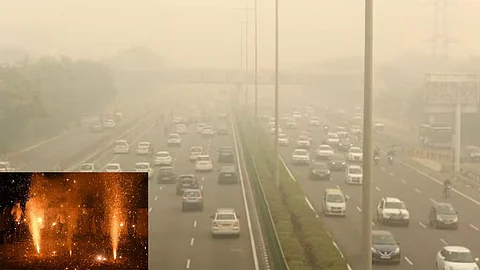

After the Diwali celebrations, AQI in Punjab and Haryana has come in the very poor category in various cities including Chandigarh, Hisar and Amritsar. These cities are experiencing hazardous pollution levels. The degraded Air Quality Index (AQI) has left residents struggling with severe health problems like breathing issues, eye irritation, and more.
In Haryana, four cities have now joined the red category for air quality whereas 12 cities are now in the orange zone. Pollution levels in Punjab, especially in cities such as Chandigarh, Jalandhar, and Patiala have become a matter of concern.
Haryana cities like Hisar, Gurugram, Fatehabad, and Charkhi Dadri have seen AQI levels soar above 300, which comes under very poor category. Hisar’s AQI was recorded at 379, just below Delhi’s level of 381, putting residents at serious risk of health issues.
Amritsar and Ludhiana, which recently showed some improvement, now have AQI levels of 188 and 184, respectively, moving them back into a safer range. However, pollution remains high in cities like Chandigarh, Jalandhar, Khanna, Mandi Gobindgarh, and Patiala, where AQI levels continue to exceed 200, posing serious health concerns for all the residents.
In the past 24 hours, no new cases of stubble burning were reported in Haryana. Punjab, however, recorded 13 incidents on Monday, bringing the season’s total to 4,145. These incidents were reported in areas such as Ferozepur, Sangrur, Bathinda, Patiala, and Faridkot.
The Supreme Court has ordered Punjab and Haryana to submit a report by 14th November that contains the details of stubble burning incidents from the past 10 days. Both states are expected to provide this data to help understand and mitigate the pollution crisis.
The central government has recently declined Punjab’s request for 1,200 crore INR to provide incentives to farmers for avoiding stubble burning. Instead, the government suggested that Punjab fund such programs from its own budget, as Haryana does.
Authorities are looking to rain as a potential way to clear the polluted air, but the Meteorological Department has predicted no rainfall until mid-November. The absence of Western Disturbances and easterly winds are preventing the usual rain pattern, which has also delayed snowfall in nearby places like Himachal Pradesh. Temperatures across North India are expected to stay 2-3 degrees above normal for this time of year which will worsen the pollution levels.